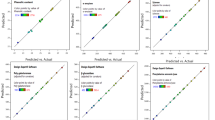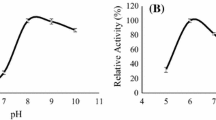Abstract
In this study, protein-rich waste of tomato processing industries was fermented by Bacillus subtilis A14h to produce hydrolysates with antioxidant and antibacterial activities. The effects of different levels of initial pH, incubation temperature, fermentation time, protein concentration and inoculum size on proteolytic activity, release of amino acids and peptides, antioxidant and antibacterial activities of hydrolysates were evaluated and optimized by using response surface methodology (RSM). Results showed that all the evaluated variables significantly influenced the hydrolysis and bioactivities of hydrolysates in polynomial models. Hydrolysates showed remarkable 2, 2′-diphenyl-1-picrylhydrazyl (DPPH) scavenging activity (up to 70 %), ferric ion reducing power, and inhibitory activity against B. cereus (up to 69.8 %) and E. coli (up to 29.8 %). Overall, good correlation between the concentration of amino acids and peptides, and antioxidant as well as antibacterial activities (in particular for B. cereus inhibition activity) was observed. Finally, optimum conditions for fermentative conversion of tomato waste proteins to antioxidant and antibacterial hydrolysates were established. Results of this study showed that tomato waste protein can be valorized to produce antioxidant and antibacterial hydrolysates in a fermentative system using B. subtilis A14h.



Similar content being viewed by others
References
Al-Wandawi H, Abdul-Rahman M, Al-Shaikhly K (1985) Tomato processing wastes as essential raw materials source. J Agric Food Chem 33(5):804–807
Baer A, Ryba I, Meyer J, Bütikofer U (1996) Microplate assay of free amino acids in Swiss cheeses. LWT-Food Sci Technol 29(1):58–62
Balakrishnan B, Prasad B, Rai AK, Velappan SP, Subbanna MN, Narayan B (2011) In vitro antioxidant and antibacterial properties of hydrolysed proteins of delimed tannery fleshings: comparison of acid hydrolysis and fermentation methods. Biodegradation 22(2):287–295
Bhaskar N, Modi V, Govindaraju K, Radha C, Lalitha RG (2007) Utilization of meat industry by products: protein hydrolysate from sheep visceral mass. Bioresour Technol 98(2):388–394
Boschin G, Scigliuolo GM, Resta D, Arnoldi A (2014) ACE-inhibitory activity of enzymatic protein hydrolysates from lupin and other legumes. Food Chem 145:34–40
Corrêa APF, Daroit DJ, Fontoura R, Meira SMM, Segalin J, Brandelli A (2014) Hydrolysates of sheep cheese whey as a source of bioactive peptides with antioxidant and angiotensin-converting enzyme inhibitory activities. Peptides 61:48–55
Dey SS, Dora KC (2014) Antioxidative activity of protein hydrolysate produced by alcalase hydrolysis from shrimp waste (Penaeus monodon and Penaeus indicus). J Food Sci Technol 51(3):449–457
Fakhfakh N, Ktari N, Siala R, Nasri M (2013) Wool‐waste valorization: production of protein hydrolysate with high antioxidative potential by fermentation with a new keratinolytic bacterium, Bacillus pumilus A1. J Appl Microbiol 115(2):424–433
Fontoura R, Daroit DJ, Correa AP, Meira SM, Mosquera M, Brandelli A (2014) Production of feather hydrolysates with antioxidant, angiotensin-I converting enzyme-and dipeptidyl peptidase-IV-inhibitory activities. New Biotechnol 31(5):506–513
Guerard F, Sumaya-Martinez MT, Laroque D, Chabeaud A, Dufossé L (2007) Optimization of free radical scavenging activity by response surface methodology in the hydrolysis of shrimp processing discards. Process Biochem 42(11):1486–1491
He R, Ju X, Yuan J, Wang L, Girgih AT, Aluko RE (2012) Antioxidant activities of rapeseed peptides produced by solid state fermentation. Food Res Int 49(1):432–438
Helrich K (1990) Official methods of analysis of the AOAC, vol 2. Association of Official Analytical Chemists Inc.
Hu Y, Ge C, Yuan W, Zhu R, Zhang W, Du L, Xue J (2010) Characterization of fermented black soybean natto inoculated with Bacillus natto during fermentation. J Sci Food Agric 90(7):1194–1202
Huang Y-H, Lai Y-J, Chou C-C (2011) Fermentation temperature affects the antioxidant activity of the enzyme-ripened sufu, an oriental traditional fermented product of soybean. J Biosci Bioeng 112(1):49–53
Hur SJ, Lee SY, Kim Y-C, Choi I, Kim G-B (2014) Effect of fermentation on the antioxidant activity in plant-based foods. Food Chem 160:346–356
Jemil I, Jridi M, Nasri R, Ktari N, Salem R B S-B, Mehiri M …. Nasri M (2014) Functional, antioxidant and antibacterial properties of protein hydrolysates prepared from fish meat fermented by Bacillus subtilis A26. Process Biochem 49(6):963–972
Kembhavi AA, Kulkarni A, Pant A (1993) Salt-tolerant and thermostable alkaline protease from Bacillus subtilis NCIM No. 64. Appl Biochem Biotechnol 38(1–2):83–92
Lee JK, Jeon J-K, Byun H-G (2014) Antihypertensive effect of novel angiotensin I converting enzyme inhibitory peptide from chum salmon (Oncorhynchus keta) skin in spontaneously hypertensive rats. J Funct Foods 7:381–389
Limón RI, Peñas E, Torino MI, Martínez-Villaluenga C, Dueñas M, Frias J (2015) Fermentation enhances the content of bioactive compounds in kidney bean extracts. Food Chem 172:343–352
Naqash SY, Nazeer R (2013) Antioxidant and functional properties of protein hydrolysates from pink perch (Nemipterus japonicus) muscle. J Food Sci Technol 50(5):972–978
Salami M, Moosavi-Movahedi A A, Ehsani M R, Yousefi R, Haertlé T, Chobert J-M … Ebadi S A (2010) Improvement of the antimicrobial and antioxidant activities of camel and bovine whey proteins by limited proteolysis. J Agric Food Chem 58(6):3297–3302
Sari YW, Bruins ME, Sanders JP (2013) Enzyme assisted protein extraction from rapeseed, soybean, and microalgae meals. Ind Crop Prod 43:78–83
Shahidi F, Zhong Y (2008) Bioactive peptides. J AOAC Int 91(4):914–931
Sheih I-C, Fang TJ, Wu T-K (2009) Isolation and characterisation of a novel angiotensin I-converting enzyme (ACE) inhibitory peptide from the algae protein waste. Food Chem 115(1):279–284
Sila A, Nedjar-Arroume N, Hedhili K, Chataigné G, Balti R, Nasri M … Bougatef A (2014) Antibacterial peptides from barbel muscle protein hydrolysates: activity against some pathogenic bacteria. LWT-Food Sci Technol 55(1):183–188
Siow H-L, Gan C-Y (2013) Extraction of antioxidative and antihypertensive bioactive peptides from Parkia speciosa seeds. Food Chem 141(4):3435–3442
Sogi D, Arora M, Garg S, Bawa A (2002) Fractionation and electrophoresis of tomato waste seed proteins. Food Chem 76(4):449–454
Thavasi V, Bettens RPA, Leong LP (2009) Temperature and solvent effects on radical scavenging ability of phenols. J Phys Chem A 113(13):3068–3077
Udenigwe CC, Aluko RE (2012) Food protein‐derived bioactive peptides: production, processing, and potential health benefits. J Food Sci 77(1):R11–R24
Wu W, Zhao S, Chen C, Ge F, Liu D, He X (2014) Optimization of production conditions for antioxidant peptides from walnut protein meal using solid-state fermentation. Food Sci Biotechnol 23(6):1941–1949
Zhang Y, Liu J, Lu X, Zhang H, Wang L, Guo X … Qian H (2014) Isolation and identification of an antioxidant peptide prepared from fermented peanut meal using Bacillus subtilis fermentation. Int J Food Prop 17(6):1237–1253
Author information
Authors and Affiliations
Corresponding authors
Rights and permissions
About this article
Cite this article
Moayedi, A., Hashemi, M. & Safari, M. Valorization of tomato waste proteins through production of antioxidant and antibacterial hydrolysates by proteolytic Bacillus subtilis: optimization of fermentation conditions. J Food Sci Technol 53, 391–400 (2016). https://doi.org/10.1007/s13197-015-1965-2
Revised:
Accepted:
Published:
Issue Date:
DOI: https://doi.org/10.1007/s13197-015-1965-2




